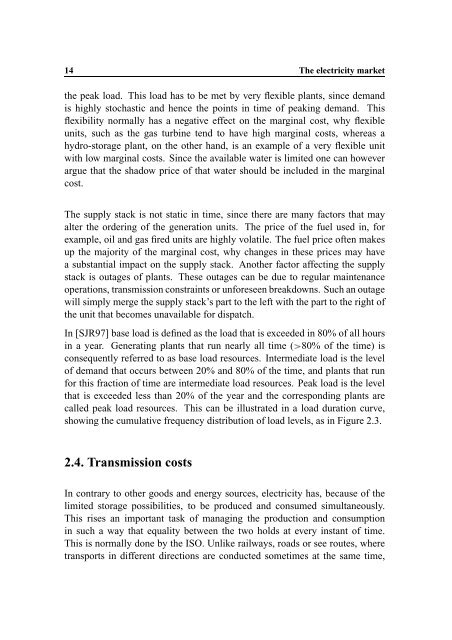Hedging Strategy and Electricity Contract Engineering - IFOR
Hedging Strategy and Electricity Contract Engineering - IFOR
Hedging Strategy and Electricity Contract Engineering - IFOR
You also want an ePaper? Increase the reach of your titles
YUMPU automatically turns print PDFs into web optimized ePapers that Google loves.
14 The electricity market<br />
the peak load. This load has to be met by very flexible plants, since dem<strong>and</strong><br />
is highly stochastic <strong>and</strong> hence the points in time of peaking dem<strong>and</strong>. This<br />
flexibility normally has a negative effect on the marginal cost, why flexible<br />
units, such as the gas turbine tend to have high marginal costs, whereas a<br />
hydro-storage plant, on the other h<strong>and</strong>, is an example of a very flexible unit<br />
with low marginal costs. Since the available water is limited one can however<br />
argue that the shadow price of that water should be included in the marginal<br />
cost.<br />
The supply stack is not static in time, since there are many factors that may<br />
alter the ordering of the generation units. The price of the fuel used in, for<br />
example, oil <strong>and</strong> gas fired units are highly volatile. The fuel price often makes<br />
up the majority of the marginal cost, why changes in these prices may have<br />
a substantial impact on the supply stack. Another factor affecting the supply<br />
stack is outages of plants. These outages can be due to regular maintenance<br />
operations, transmission constraints or unforeseen breakdowns. Such an outage<br />
will simply merge the supply stack’s part to the left with the part to the right of<br />
the unit that becomes unavailable for dispatch.<br />
In [SJR97] base load is defined as the load that is exceeded in 80% of all hours<br />
in a year. Generating plants that run nearly all time ( 80% of the time) is<br />
consequently referred to as base load resources. Intermediate load is the level<br />
of dem<strong>and</strong> that occurs between 20% <strong>and</strong> 80% of the time, <strong>and</strong> plants that run<br />
for this fraction of time are intermediate load resources. Peak load is the level<br />
that is exceeded less than 20% of the year <strong>and</strong> the corresponding plants are<br />
called peak load resources. This can be illustrated in a load duration curve,<br />
showing the cumulative frequency distribution of load levels, as in Figure 2.3.<br />
2.4. Transmission costs<br />
In contrary to other goods <strong>and</strong> energy sources, electricity has, because of the<br />
limited storage possibilities, to be produced <strong>and</strong> consumed simultaneously.<br />
This rises an important task of managing the production <strong>and</strong> consumption<br />
in such a way that equality between the two holds at every instant of time.<br />
This is normally done by the ISO. Unlike railways, roads or see routes, where<br />
transports in different directions are conducted sometimes at the same time,
















